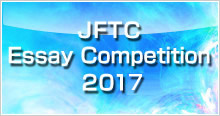Remarks by Selection Committee Chair, Mr. Atsushi Nakajima
I have the distinct honor of serving as the new chair of the Selection Committee for the JFTC Essay Competition. I would like to express my deepest appreciation for the efforts made over the years by JFTC, ex-chair Dr. Iwao Nakatani, the vice chair, and the committee members in making this competition an event where many high quality essays on both domestic and international critical issues are submitted not only from Japan but also from all over the world.
The topic for this year’s essay was “Japan’s policy direction in the global economy - Growth strategy to revitalize the economy and Japan’s contribution to the world-,” where we solicited suggestions on the direction Japan should take for a better future under the Abenomics policies. It is my pleasure to inform you that 186 essays were submitted, which, although in terms of number, it ranks second all-time to that submitted last year, but in terms of the ratio of non-Japanese participants, who are mainly in their 20s, it was the highest ever at 71%. Considering the objective of this competition, we are extremely pleased with this new achievement.
What was significant this year was that many young people from abroad pointed out that Japan’s competitive edge resides in its culture and spoke highly of the “Cool Japan” culture. In addition, many of them mentioned that what is required to revive and revitalize the economy is a more positive attitude by the Japanese people, which can mean that they are interested to see if the Japanese people can exercise their power to transform our long-stagnant country. Although no essay was selected for the Grand Prize this year, all of the prize-winning essays presented unique viewpoints, and three essays for the Prize for Excellence and one essay for the Selection Committee Chair’s Special Prize were selected. I also would like to thank all of the members of the Selection Committee for their time and effort in reading through so many essays to make the tough decision on selecting the best ones.
The Prize for Excellence
Mr. Tetsuo Mizunuma:
“Is it possible to replicate Silicon Valley in Japan?”
Mr. Mizunuma explains that one of the success factors of Silicon Valley is that its highly advanced technologies were developed through a network in the area during a short period of time and were propelled to be an innovation. Silicon Valley denizens have a strong belief that new technologies and innovation can resolve many social issues. Mr. Mizunuma suggests that, aiming to replicate this Silicon Valley model, the Japanese people should resolve social issues with a clear awareness of each individual that these challenges are his/her own but at the same time building a stronger network for them to collaborate.
His view on the innovation capability of Silicon Valley is unique, and his convincing argument scored highly. Although the ideas on how to combine and integrate the traditional Japanese style and the Silicon Valley model were missing in this essay, his concept of connecting innovation to social contribution on an individual basis is inspiring for Japan’s future direction. For this basis, this essay was selected for the Prize of Excellence.
The Prize for Excellence
Mr. Yam Huo Ow:
“Japan as a Revitalized Hub: Industries, Policies and Capacity Building Issues”
Mr. Ow suggests that Japan should become a hub for the global network and set the direction for the future as a leader and a visionary in various fields such as technology. He describes how Japan should function as a hub in tourism, healthcare, green technology, creative industry— so-called “Cool Japan,” transport, financial services, and trading.
His analysis is based on solid reasoning, and his suggestions are well-rounded. Furthermore, the term “hub,” which still is not a familiar word in Japan, as a key word to build his argument makes this essay original and interesting. Although further clarification for the relationship between each industry and hub was desired, we found his essay to be astute. The emphasis on Japan’s global contribution was also widely accepted. For this basis, this essay scored highly.
The Prize for Excellence
Mr. Ryuichiro Izumi:
“TWO INNOVATIONS – when two innovations merge-”
Mr. Izumi discusses that by combining the prowess of small- and medium-sized businesses for technological innovation with the expertise of Sogo Shosha in market innovation, Japanese companies will be able to exploit more unmet needs and develop products and businesses to satisfy them.
His viewpoint is clear, and the argument on how Japan can grow and make contributions to the world is convincing based on supporting data. The essay is also well-structured. I would also like to mention that he is very young and is still in school. Considering his situation, it is commendable and scored highly.
The Selection Committee Chair’s Special Prize
Ms. Soo Teng Yong:
“Reclaiming Japan -Japan as a Cultural Mecca”
Ms. Yong discusses that for Japan to grow and to improve its “brand image,” the “Cool Japan” strategy is the best way to accomplish this. She describes in detail the ideas for this strategy to succeed by dividing the target population into two groups: otakus and non-otakus. This essay is not only full of original ideas but also enthusiasm in the way she earnestly explains the policies as she classifies herself as an otaku. Although the essay may not be as well-structured as the other prize-winning essays and the discussion may be somewhat naïve, it is exemplary for a person from a younger generation. Therefore, this was selected for the Selection Committee Chair’s Special Prize.

